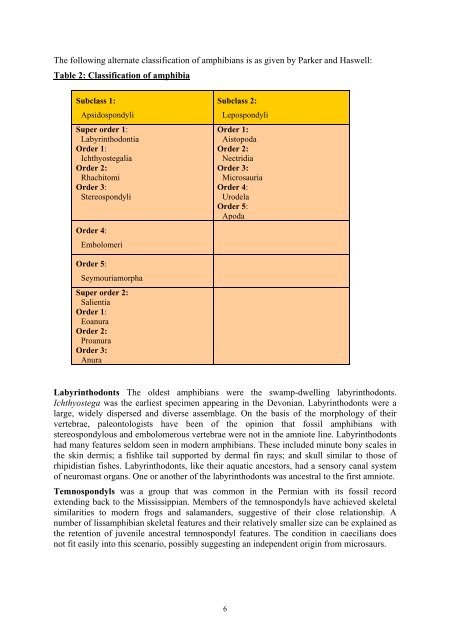Animal Diversity: Chordata
Animal Diversity: Chordata
Animal Diversity: Chordata
You also want an ePaper? Increase the reach of your titles
YUMPU automatically turns print PDFs into web optimized ePapers that Google loves.
The following alternate classification of amphibians is as given by Parker and Haswell:<br />
Table 2: Classification of amphibia<br />
Subclass 1:<br />
Apsidospondyli<br />
Super order 1:<br />
Labyrinthodontia<br />
Order 1:<br />
Ichthyostegalia<br />
Order 2:<br />
Rhachitomi<br />
Order 3:<br />
Stereospondyli<br />
Order 4:<br />
Embolomeri<br />
Order 5:<br />
Seymouriamorpha<br />
Super order 2:<br />
Salientia<br />
Order 1:<br />
Eoanura<br />
Order 2:<br />
Proanura<br />
Order 3:<br />
Anura<br />
Subclass 2:<br />
Lepospondyli<br />
Order 1:<br />
Aistopoda<br />
Order 2:<br />
Nectridia<br />
Order 3:<br />
Microsauria<br />
Order 4:<br />
Urodela<br />
Order 5:<br />
Apoda<br />
Labyrinthodonts The oldest amphibians were the swamp-dwelling labyrinthodonts.<br />
Ichthyostega was the earliest specimen appearing in the Devonian. Labyrinthodonts were a<br />
large, widely dispersed and diverse assemblage. On the basis of the morphology of their<br />
vertebrae, paleontologists have been of the opinion that fossil amphibians with<br />
stereospondylous and embolomerous vertebrae were not in the amniote line. Labyrinthodonts<br />
had many features seldom seen in modern amphibians. These included minute bony scales in<br />
the skin dermis; a fishlike tail supported by dermal fin rays; and skull similar to those of<br />
rhipidistian fishes. Labyrinthodonts, like their aquatic ancestors, had a sensory canal system<br />
of neuromast organs. One or another of the labyrinthodonts was ancestral to the first amniote.<br />
Temnospondyls was a group that was common in the Permian with its fossil record<br />
extending back to the Mississippian. Members of the temnospondyls have achieved skeletal<br />
similarities to modern frogs and salamanders, suggestive of their close relationship. A<br />
number of lissamphibian skeletal features and their relatively smaller size can be explained as<br />
the retention of juvenile ancestral temnospondyl features. The condition in caecilians does<br />
not fit easily into this scenario, possibly suggesting an independent origin from microsaurs.<br />
6

















